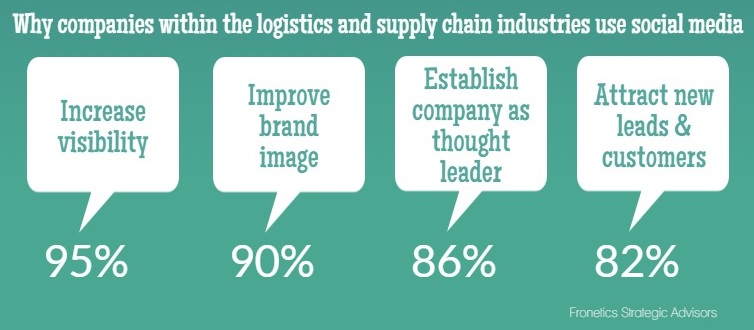
by Fronetics | Oct 14, 2014 | Blog, Logistics, Manufacturing & Distribution, Marketing, Social Media, Strategy, Supply Chain
Social media is a strategic tool. The benefits companies can realize by using social media are immense. Which benefits are motivating companies within the logistics and supply chain to use social media? Even more broadly, why are companies using social media?
A recent survey conducted by Fronetics Strategic Advisors found that the predominant reasons companies within the logistics and supply chain industries use social media are to: increase the visibility of their company; to improve their brand image; establish their company as a thought leader; and to attract new leads and customers.

To learn more about the use, motivations, benefits, and challenges of social media and the logistics and supply chain industries, download our report: Social media and the logistics and supply chain industries.


by Fronetics | Oct 14, 2014 | Blog, Logistics, Manufacturing & Distribution, Marketing, Social Media, Strategy, Supply Chain
Social media is a strategic tool. The benefits companies can realize by using social media are immense. Which benefits are motivating companies within the logistics and supply chain to use social media? Even more broadly, why are companies using social media?
A recent survey conducted by Fronetics Strategic Advisors found that the predominant reasons companies within the logistics and supply chain industries use social media are to: increase the visibility of their company; to improve their brand image; establish their company as a thought leader; and to attract new leads and customers.

To learn more about the use, motivations, benefits, and challenges of social media and the logistics and supply chain industries, download our report: Social media and the logistics and supply chain industries.


by Fronetics | Oct 9, 2014 | Blog, Logistics, Marketing, Social Media, Strategy, Supply Chain
Report on social media use, motivations, preferences, benefits, and challenges.
Within the past five years companies within the logistics and supply chain industries have begun to see social media as a strategic tool and have begun to actively use and leverage social media.
A survey conducted by Fronetics Strategic Advisors looks, broadly, at the use of social media within the logistics and supply chain industries. The report discusses use, motivations, preferences, benefits, and challenges.
Key findings include:
- 68% of survey respondents report that their company has realized benefits by participating in social media.
- Increased engagement with customers, market intelligence, and business intelligence are primary benefits realized by companies.
- Companies are turning to social media to establish and advance their brand and image.
- The majority of companies are currently managing their social media strategy in-house.
- Twitter, LinkedIn and Facebook are the social networks most commonly used by companies.
- Twitter and LinkedIn are perceived to have the greatest business impact.
- Time constraints, budget constraints, and a lack of an identified strategy are the key challenges identified by respondents.
To learn more about social media and the logistics and supply chain industries, download the report.


by Fronetics | Oct 9, 2014 | Blog, Logistics, Marketing, Social Media, Strategy, Supply Chain
Report on social media use, motivations, preferences, benefits, and challenges.
Within the past five years companies within the logistics and supply chain industries have begun to see social media as a strategic tool and have begun to actively use and leverage social media.
A survey conducted by Fronetics Strategic Advisors looks, broadly, at the use of social media within the logistics and supply chain industries. The report discusses use, motivations, preferences, benefits, and challenges.
Key findings include:
- 68% of survey respondents report that their company has realized benefits by participating in social media.
- Increased engagement with customers, market intelligence, and business intelligence are primary benefits realized by companies.
- Companies are turning to social media to establish and advance their brand and image.
- The majority of companies are currently managing their social media strategy in-house.
- Twitter, LinkedIn and Facebook are the social networks most commonly used by companies.
- Twitter and LinkedIn are perceived to have the greatest business impact.
- Time constraints, budget constraints, and a lack of an identified strategy are the key challenges identified by respondents.
To learn more about social media and the logistics and supply chain industries, download the report.


by Fronetics | Oct 7, 2014 | Blog, Strategy, Supply Chain

Figuring out how to consistently attract the right kinds of leads and meaningfully connect with prospects can be a daunting task. Producing significant returns on your investment, though, is the initial effort of creating a road map for your success. Introducing a standardized sales approach in your organization can increase sales revenue, create clear expectations, and eliminate process ambiguity. But beyond establishing clear objectives and defining measures of success, the development stage of creating a standard sales process should include consideration of a number of internal and external factors. As you begin to craft a strategy of your own, consider how your plan will incorporate these best practices.
Generate Better Qualified Leads
Generating well-qualified leads creates a streamlined and more efficient sales team. Efforts to attract the right kinds of leads should start well before anyone from sales enters the process, though. A standardized sales process allows others in the organization to set the framework for success. Working with the sales team, marketers can determine what questions your ideal customer might be searching for and use content to address those questions in a way that will resonate with prospects. Providing relevant value for the buyer establishes parameters for attracting more qualified leads. By generating better leads, your sales team will enjoy a shorter sales cycle and reduce wasted effort on opportunities that are unlikely to close.
Standardize Sales Procedures
Establish and institutionalize typical sales procedures; each department with either direct or indirect contribution to the sales team should understand and operate using the same processes and assumptions. This continuity removes ambiguous procedures, eliminates uncommon language, allows for team members to anticipate when support might be needed, and helps the organization to pre-plan for workloads as sales close.
Remove Barriers to Implementation and Continued Use
Create value in the sales process, not only for the buyer, but for the organization itself. What benefit will the current activities of your organization bring? Of great importance when considering the development and implementation of a standardized sales process is the ease of implementation and likelihood of continued use. How likely is it that your team will adopt this method? How likely is it to be around ten months from now? Does this process create unnecessary redundancy? Are you maximizing the amount of time your team spends on revenue-generating activities? Spending some time thinking through exactly how and why the process will be used by those in your organization will help guide your decisions in the process development.
Allow for Flexibility
The most significant benefit of implementing a standardized sales process is its structured approach. However, allowing for occasional flexibility in both the structure and application of the process gives your sales team the necessary autonomy to close unorthodox sales. Some leads require a slightly different approach – will your process allow for your team to adapt procedures as necessary? Similarly, requesting and considering feedback from regular users informs decisions to adjust or modify the standard sales process as needed.
Establishing a successful sales process requires building a solid foundation through the thoughtful and deliberate development of a process. Having a well-designed process to guide your daily activities will better position your organization to attract better qualified leads and close more sales.

by Fronetics | Oct 7, 2014 | Blog, Strategy, Supply Chain

Figuring out how to consistently attract the right kinds of leads and meaningfully connect with prospects can be a daunting task. Producing significant returns on your investment, though, is the initial effort of creating a road map for your success. Introducing a standardized sales approach in your organization can increase sales revenue, create clear expectations, and eliminate process ambiguity. But beyond establishing clear objectives and defining measures of success, the development stage of creating a standard sales process should include consideration of a number of internal and external factors. As you begin to craft a strategy of your own, consider how your plan will incorporate these best practices.
Generate Better Qualified Leads
Generating well-qualified leads creates a streamlined and more efficient sales team. Efforts to attract the right kinds of leads should start well before anyone from sales enters the process, though. A standardized sales process allows others in the organization to set the framework for success. Working with the sales team, marketers can determine what questions your ideal customer might be searching for and use content to address those questions in a way that will resonate with prospects. Providing relevant value for the buyer establishes parameters for attracting more qualified leads. By generating better leads, your sales team will enjoy a shorter sales cycle and reduce wasted effort on opportunities that are unlikely to close.
Standardize Sales Procedures
Establish and institutionalize typical sales procedures; each department with either direct or indirect contribution to the sales team should understand and operate using the same processes and assumptions. This continuity removes ambiguous procedures, eliminates uncommon language, allows for team members to anticipate when support might be needed, and helps the organization to pre-plan for workloads as sales close.
Remove Barriers to Implementation and Continued Use
Create value in the sales process, not only for the buyer, but for the organization itself. What benefit will the current activities of your organization bring? Of great importance when considering the development and implementation of a standardized sales process is the ease of implementation and likelihood of continued use. How likely is it that your team will adopt this method? How likely is it to be around ten months from now? Does this process create unnecessary redundancy? Are you maximizing the amount of time your team spends on revenue-generating activities? Spending some time thinking through exactly how and why the process will be used by those in your organization will help guide your decisions in the process development.
Allow for Flexibility
The most significant benefit of implementing a standardized sales process is its structured approach. However, allowing for occasional flexibility in both the structure and application of the process gives your sales team the necessary autonomy to close unorthodox sales. Some leads require a slightly different approach – will your process allow for your team to adapt procedures as necessary? Similarly, requesting and considering feedback from regular users informs decisions to adjust or modify the standard sales process as needed.
Establishing a successful sales process requires building a solid foundation through the thoughtful and deliberate development of a process. Having a well-designed process to guide your daily activities will better position your organization to attract better qualified leads and close more sales.





